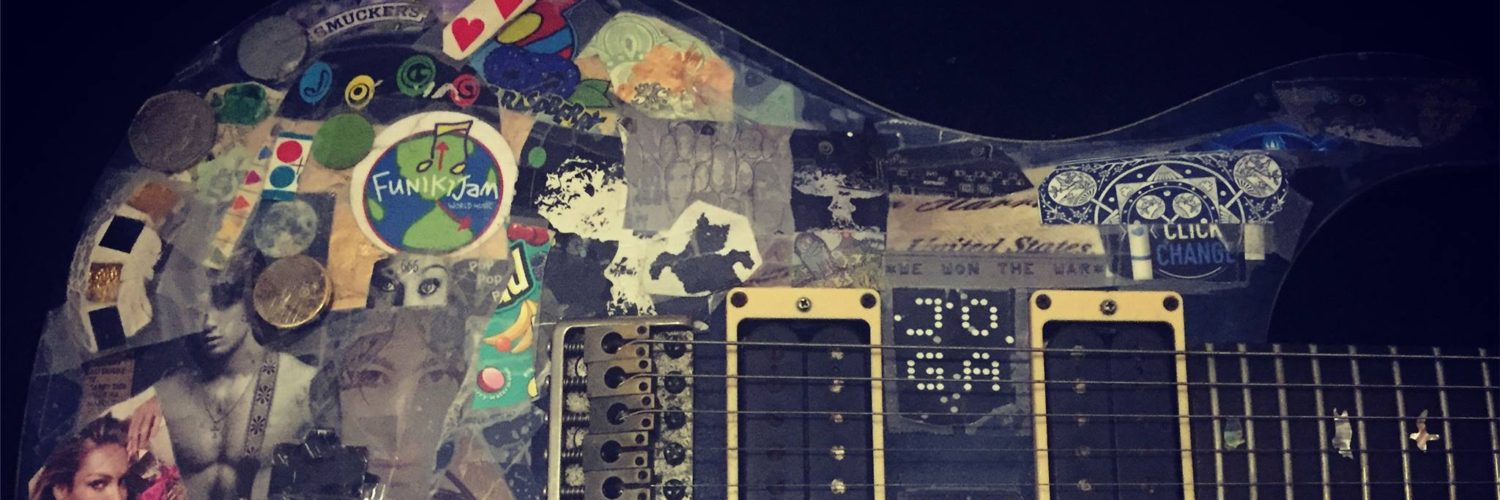
.
-as of [19 JUNE 2025]-
.
.
.
-the guitar is a ‘musical instrument’ classified as a ‘fretted string instrument’ with anywhere from ‘4’ to ’18’ strings, usually having ‘6’-
.
(“i really need to acquire a ’12-string guitar’)
(if only to confirm my ‘duodecimalist’ sympathies)
(by ‘doubling up’ on ‘6’ so to speak)
.
(the ‘sound’ is projected either ‘acoustically’ (using a hollow ‘wooden’ or ‘plastic and wood’ box (for an ‘acoustic guitar’), or through ‘electrical amplifier’ and a ‘speaker’ (for an ‘electric guitar’))
(it is typically played by ‘strumming’ or ‘plucking’ the strings with the (‘fingers’ / ‘thumb’ / ‘fingernails’ of the ‘right hand’ or with a ‘pick’ while ‘fretting’ (or pressing against the frets) the strings with the ‘fingers’ of the ‘left hand’)
(the guitar is a type of ‘chordophone’, traditionally constructed from ‘wood’ + strung with either (‘gut’ / ‘nylon’ / ‘steel’) strings and distinguished from other ‘chordophones’ by its ‘construction’ + ‘tuning’)
.
(the ‘modern guitar’ was preceded by…)
*the ‘gittern’*
.
*the ‘vihuela’*
.
*the ‘4-course renaissance guitar’*
.
*the ‘5-course baroque guitar’*
.
(all of which contributed to the development of the ‘modern 6-string instrument’)
.
.
(there are 3 main types of ‘modern acoustic guitar’…)
#1
*the ‘classical guitar’*
(aka ‘nylon-string guitar’)
.
#2
*the ‘steel-string acoustic guitar’*
.
#3
*the ‘arch-top guitar’*
(aka ”jazz guitar”)
.
(the ‘tone’ of an ‘acoustic guitar’ is produced by the ‘strings’ vibration’, amplified by the ‘hollow body’ of the ‘guitar’, which acts as a ‘resonating chamber’)
(the ‘classical guitar’ is often played as a ‘solo instrument’ using a ‘comprehensive finger-picking technique’ where each string is plucked individually by the player’s fingers (as opposed to being ‘strummed’))
(the term “finger-picking” can also refer to a specific tradition of (‘folk’ / ‘blues’ / ‘bluegrass’ / ‘country’) guitar playing in the ‘united states’)
(the ‘acoustic bass guitar’ is a ‘low-pitched instrument’ that is 1 octave below a ‘regular guitar’)
(‘electric guitars’ (introduced in the ‘1930s’) use an ‘amplifier’ + a ‘loudspeaker’ that both makes the sound of the instrument loud enough for the ‘performers’ + ‘audience’ to hear, and (given that it produces an ‘electric signal’) when played, that can electronically ‘manipulate’ + ‘shape’ the ‘tone’ using an ‘equalizer’ (aka ‘bass tone’ + ‘treble tone’ controls) and a huge variety of ‘electronic effects units’, the most commonly used ones being ‘distortion’ (aka “overdrive”) + ‘reverb’)
(early ‘amplified guitars’ employed a ‘hollow body’, but a ‘solid wood body’ was eventually found more suitable during the ‘1960s’ + ‘1970s’, as it was less prone to unwanted acoustic feedback “howls”)
.
(as with ‘acoustic guitars’, there are a # of types of ‘electric guitars’, including…)
*’hollowbody guitars’*
.
*’arch-top guitars’*
(widely used in ‘jazz’ / ‘blues’ / ‘rockabilly’)
.
*’solid-body guitars’*
(widely used in ‘rock music’)
.
(the ‘loud ‘amplified sound’ + ‘sonic power’ of the ‘electric guitar’ played through a ‘guitar amp’ has played a key role in the development of ‘blues’ + ‘rock’ music, both as an ‘accompaniment instrument’ (playing ‘riffs’ + ‘chords’) and performing ‘guitar solos’)
(it has also had a huge effect on many ‘rock subgenres’)
(notably ‘heavy metal’ + ‘punk rock’)
.
(the ‘electric guitar’ has had a major influence on ‘popular culture’)
.
(the ‘guitar’ is used in a wide variety of ‘musical genres’ worldwide)
.
(it is recognized as a ‘primary instrument’ in ‘genres’ such as…)
‘blues’
‘bluegrass’
‘country’
‘flamenco’
‘folk’
‘jazz’
’jota’
‘mariachi’
‘metal’
‘punk’
‘reggae’
‘rock’
‘soul’
‘pop’
(in many forms)
.
.
*👨🔬🕵️♀️🙇♀️*SKETCHES*🙇♂️👩🔬🕵️♂️*
.
.
.
👈👈👈☜*“TOOLS OF THE TRADE”* ☞ 👉👉👉
.
.
💕💝💖💓🖤💙🖤💙🖤💙🖤❤️💚💛🧡❣️💞💔💘❣️🧡💛💚❤️🖤💜🖤💙🖤💙🖤💗💖💝💘
.
.
*🌈✨ *TABLE OF CONTENTS* ✨🌷*
.
.
🔥🔥🔥🔥🔥🔥*we won the war* 🔥🔥🔥🔥🔥🔥
